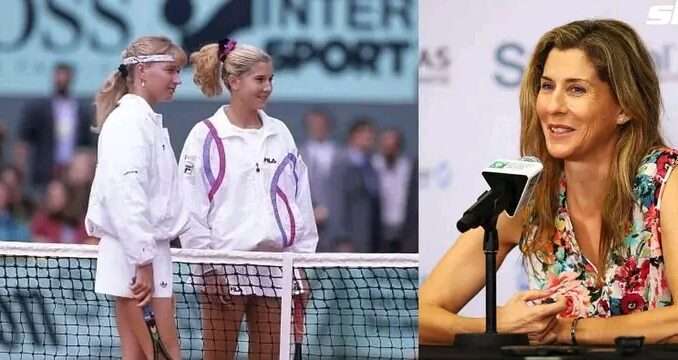
breaking:-Monica Seles Reflects on Steffi Graf’s 66-Match Winning Streak at the 1990 Lufthansa Cup: “I Wasn’t Afraid of Steffi Graf as Before… I’d Like a Lamborghini.
In the spring of 1990, the tennis world witnessed a seismic shift. At the Lufthansa Cup in Berlin, a 16-year-old Monica Seles did what no other player had managed to do in over a year—defeat the indomitable Steffi Graf, ending the German superstar’s 66-match winning streak. The match didn’t just mark the rise of a new tennis phenom; it also symbolized a power shift in women’s tennis. Years later, Seles would look back on that iconic match with a mix of pride, humor, and youthful exuberance.
Steffi Graf’s 66-match win streak remains one of the most impressive feats in tennis history. During that run, Graf had vanquished every challenger in sight with a combination of relentless power, unmatched athleticism, and mental resilience. Coming into the Lufthansa Cup, she was the undisputed queen of the court and a heavy favorite, especially playing on home soil in Berlin. But Monica Seles, the Yugoslavian-born rising star, had different plans.
In the final, Seles stunned both the tennis establishment and the home crowd by defeating Graf 6-4, 6-3 in just 65 minutes. The teenager played with fearless aggression, returning Graf’s blistering forehands with interest and dictating play with her double-handed groundstrokes from both sides. What set Seles apart wasn’t just her talent—it was her unshakable confidence.
In interviews reflecting on that pivotal moment, Seles revealed what had changed in her mindset. “I wasn’t afraid of Steffi Graf as before,” she said. “Something shifted in me. I respected her tremendously—she was my idol—but I started believing I could win.” That belief propelled her to one of the biggest victories of her early career, catapulting her into the global spotlight.
The win also came with a hefty $100,000 prize, an enormous sum for a teenager in 1990. When asked what she planned to do with her prize money, Seles replied with youthful charm: “I’d like a Lamborghini.” While it’s unclear whether she ever bought the car, the statement reflected her personality—playful, ambitious, and refreshingly candid. It also marked a shift in the culture of women’s sports, where young athletes were becoming icons in their own right.
The 1990 Lufthansa Cup final was more than just an upset—it was a generational clash. Graf, the composed and dominant champion, met her match in Seles, whose fearless game and emotional intensity signaled a new era. Over the next few years, Seles would go on to dominate the women’s tour, winning eight Grand Slam titles before the tragic on-court stabbing in 1993 temporarily halted her career.
Looking back, Seles’s win over Graf in Berlin is now seen as the moment the tennis world was put on notice. The teenager who once idolized Graf had grown into her fiercest competitor. It was the start of a rivalry that helped define a golden age of women’s tennis in the 1990s.

What makes the story even more remarkable is the grace with which both players handled their roles in this historic match. Graf, though disappointed, continued her legendary career, adding more Grand Slam titles and further cementing her legacy. Seles, meanwhile, became a symbol of youthful determination, passion, and perseverance—qualities that endeared her to fans worldwide.
More than three decades later, Monica Seles’s reflections on that day still carry the weight of history, and a touch of lightness. “I wasn’t afraid anymore,” she recalled. “And after the match, all I could think was—maybe it’s time for a Lamborghini.” The statement may have been made in jest, but the confidence behind it was very real—and it changed the course of tennis history.
Let me know if you’d like to explore the Graf-Seles rivalry in more depth or look into Seles’s career post-1993 comeback.
In the spring of 1990, the tennis world witnessed a seismic shift. At the Lufthansa Cup in Berlin, a 16-year-old Monica Seles did what no other player had managed to do in over a year—defeat the indomitable Steffi Graf, ending the German superstar’s 66-match winning streak. The match didn’t just mark the rise of a new tennis phenom; it also symbolized a power shift in women’s tennis. Years later, Seles would look back on that iconic match with a mix of pride, humor, and youthful exuberance.
Steffi Graf’s 66-match win streak remains one of the most impressive feats in tennis history. During that run, Graf had vanquished every challenger in sight with a combination of relentless power, unmatched athleticism, and mental resilience. Coming into the Lufthansa Cup, she was the undisputed queen of the court and a heavy favorite, especially playing on home soil in Berlin. But Monica Seles, the Yugoslavian-born rising star, had different plans.
In the final, Seles stunned both the tennis establishment and the home crowd by defeating Graf 6-4, 6-3 in just 65 minutes. The teenager played with fearless aggression, returning Graf’s blistering forehands with interest and dictating play with her double-handed groundstrokes from both sides. What set Seles apart wasn’t just her talent—it was her unshakable confidence.
In interviews reflecting on that pivotal moment, Seles revealed what had changed in her mindset. “I wasn’t afraid of Steffi Graf as before,” she said. “Something shifted in me. I respected her tremendously—she was my idol—but I started believing I could win.” That belief propelled her to one of the biggest victories of her early career, catapulting her into the global spotlight.
The win also came with a hefty $100,000 prize, an enormous sum for a teenager in 1990. When asked what she planned to do with her prize money, Seles replied with youthful charm: “I’d like a Lamborghini.” While it’s unclear whether she ever bought the car, the statement reflected her personality—playful, ambitious, and refreshingly candid. It also marked a shift in the culture of women’s sports, where young athletes were becoming icons in their own right.
The 1990 Lufthansa Cup final was more than just an upset—it was a generational clash. Graf, the composed and dominant champion, met her match in Seles, whose fearless game and emotional intensity signaled a new era. Over the next few years, Seles would go on to dominate the women’s tour, winning eight Grand Slam titles before the tragic on-court stabbing in 1993 temporarily halted her career.
Looking back, Seles’s win over Graf in Berlin is now seen as the moment the tennis world was put on notice. The teenager who once idolized Graf had grown into her fiercest competitor. It was the start of a rivalry that helped define a golden age of women’s tennis in the 1990s.
What makes the story even more remarkable is the grace with which both players handled their roles in this historic match. Graf, though disappointed, continued her legendary career, adding more Grand Slam titles and further cementing her legacy. Seles, meanwhile, became a symbol of youthful determination, passion, and perseverance—qualities that endeared her to fans worldwide.
More than three decades later, Monica Seles’s reflections on that day still carry the weight of history, and a touch of lightness. “I wasn’t afraid anymore,” she recalled. “And after the match, all I could think was—maybe it’s time for a Lamborghini.” The statement may have been made in jest, but the confidence behind it was very real—and it changed the course of tennis history.
Let me know if you’d like to explore the Graf-Seles rivalry in more depth or look into Seles’s career post -1993 comeback.
Leave a Reply